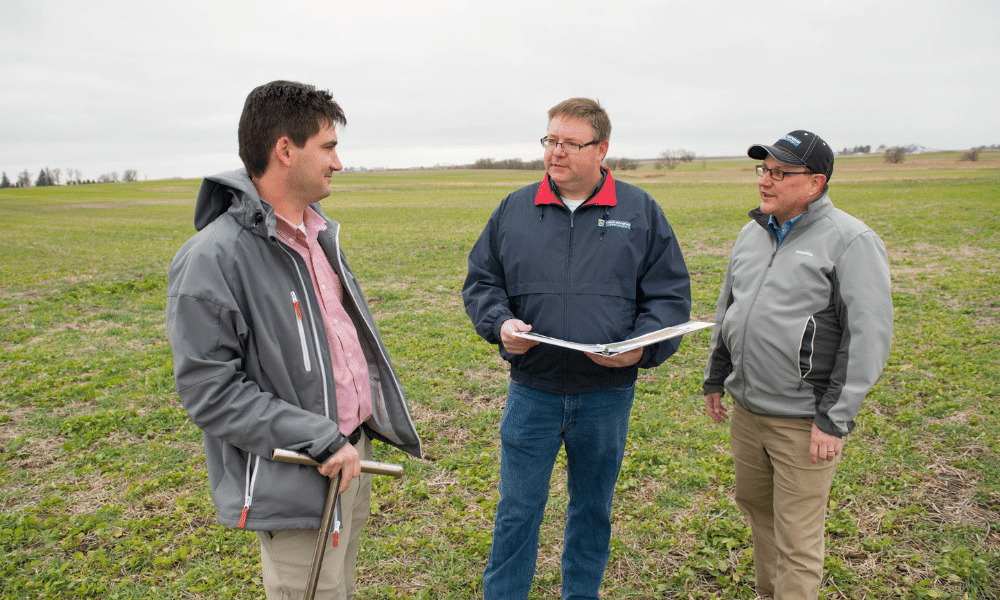
ISA researchers discuss conservation efforts that improve soybean yields, profitability and sustainability. (Photo: Iowa Soybean Association)
Relay cropping experimentation shows potential
May 5, 2021
While Iowa farmers continue to grow large quantities of soybeans and corn each year, there has been a push to incorporate small grains back on the landscape, primarily as a cover crop. Cereal rye is hardy, nitrogen scavenging and quality forage for livestock.
Modern no-till planting equipment can easily establish soybean crops into stands of living rye. It’s a practice more farmers are using to achieve stewardship, economic and agronomic goals.
Research is clear on the effect of small grains in crop rotation with warm-season crops of corn and soybeans. Extensive fibrous roots aggregate and stabilize soil and suppress weeds. Nutrient cycles change in predictable ways to reduce possible loss from the system.
There are potential challenges with growing small grains for seed, including quality issues from a humid climate, highly variable yield and inconsistent markets.
“We enjoy growing small grains for several reasons,” says Alec Amundson, who farms in Mitchell County. “Soil health benefits, additional crops in our rotation and less fall workload are among a few.
“The drawback is getting small grains to compete with corn and soybeans from a profitability standpoint,” Amundson explains. “We are lucky to have a local cover crop business that cleans and sells rye, but it is hard to compete with rye grown in the Dakota’s in quality and price.”
The old joke is that there are many reasons to grow small grains, but money usually isn’t one of them.
Joking aside, as farmers consider the big picture, one thing is clear: Iowa soils and waterways benefit from small grains on the landscape and can complement corn, soybean and livestock production.
Several Iowa farmers have been experimenting with relay crops of small grains with soybeans. This involves seeding soybeans early in the growing season while the cereal rye is still in vegetative growth stages. The soybeans grow together with the rye, and when the rye reaches maturity, it is harvested above the canopy of soybeans growing below. The soybeans then proceed to maturity generating two grain crops.
Working with Northeast Iowa Resource Conservation and Development (RC&D), Iowa Soybean Association (ISA) farmer participants have implemented replicated strip trials testing this method compared with sole crop soybeans.
Across all sites, rye yields ranged from 20-49 bushels per acre, with soybean yield reductions of 6-28 bushels compared with a sole crop (these reports are available on the research section of ISA’s website). Two sites achieved 90% of sole crop soybean yield while producing 30-40 bu/ac of rye seed.
Several strategies are necessary to help keep soybean yields comparable and get a quality seed rye crop. They include fertilizer, crop protection and soybean maturity group.
“We still have a lot to figure out when it comes to growing two crops simultaneously without too much competition between them,” says Amundson. “We’ve experimented with different populations, row spacings and planting timing, but the biggest challenges have come from the weather including lack of late summer rainfall.”
Even after accounting for additional management costs, producing seed quality rye and minimal soybean yield reductions can make economic gains and generate the soil and water quality improvements that come with growing small grains.
In 2021, more than 10 farmer participants are planning to compare relay and sole crop methods in replicated comparisons with ISA and Northeast Iowa RC&D. This will expand the knowledge base on this system for all farmers in Iowa. As farmers continue to identify the necessary management refinements and agronomic details of this system, the result will be more local seed for cover crops and forage, environmental improvements, and marketable soybean crops produced at the same time.
This story was originally published in the Spring 2021 issue of the Iowa Soybean Review.
Back